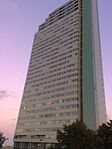Sayes Court
All pages needing cleanupBuildings and structures demolished in 1728Buildings and structures in the London Borough of LewishamDeptfordForced migration ... and 8 more
History of KentHistory of the London Borough of LewishamParks and open spaces in the London Borough of LewishamRedevelopment projects in LondonSource attributionUse British English from October 2013Wikipedia introduction cleanup from June 2019Workhouses in London

Sayes Court was a manor house and garden in Deptford, in the London Borough of Lewisham on the Thames Path and in the former parish of St Nicholas. Sayes Court once attracted throngs to visit its celebrated garden created by the seventeenth century diarist John Evelyn. Now completely buried beneath Convoys Wharf and Sayes Court Park, the area shows little sign of its former glory, despite having been a key factor in the creation of the National Trust.
Excerpt from the Wikipedia article Sayes Court (License: CC BY-SA 3.0, Authors, Images).Sayes Court
Dacca Street, London New Cross (London Borough of Lewisham)
Geographical coordinates (GPS) Address Website Nearby Places Show on map
Geographical coordinates (GPS)
| Latitude | Longitude |
|---|---|
| N 51.484941 ° | E -0.02879 ° |
Address
Convoys Wharf
Dacca Street
SE8 3LJ London, New Cross (London Borough of Lewisham, Sayes Court Estate)
England, United Kingdom
Open on Google Maps









